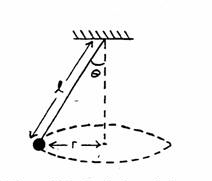Problem 6-53 parts (a), (b), and (c) Centripetal force - Part 5 - A
A conical pendulum consists of a mass (the bob) on the end of a string. As the bob travels in a horizontal circle at constant speed, the string traces out a cone. For the pendulum shown, mass \(m = 1.95\; kg\), length \(l = 1.03\; m\), and angle \(\theta = 36.9^\circ\).
(a) Draw a free body diagram for the bob at the instant shown.
(b) What force constitutes the centripetal force?
(c) Determine the speed of the bob.

Accumulated Solution

\(T \cos \theta = mg\)
Correct!
\(T \sin \theta = mv^2/r(2) \) This is the answer to part (b).
If you divide Eq (2) by Eq (1)
\(\frac{T \sin \theta}{T \cos \theta} = \frac{mv^2/r}{mg}\)
\(T\) and \(m\) both cancel leaving:
\(\frac{\sin \theta}{\cos \theta} = \frac{v^2}{rg}\)
In terms of \(l\) and \(\theta\), \(r\) is given by:
(A) \(r = l \cos \theta\)
(B) \(r = l \sin \theta\)